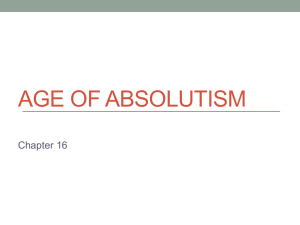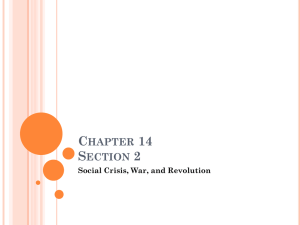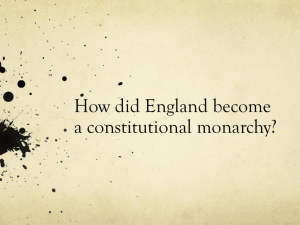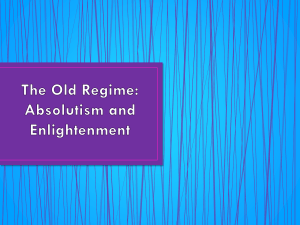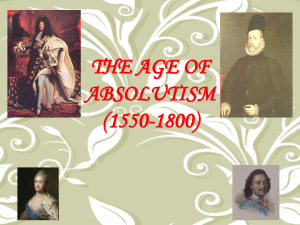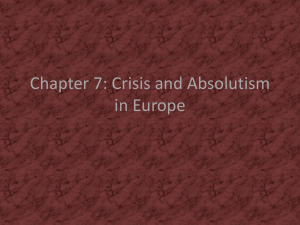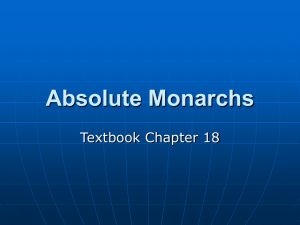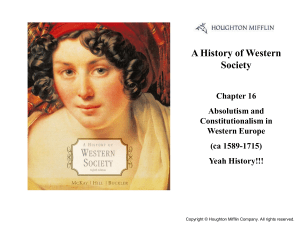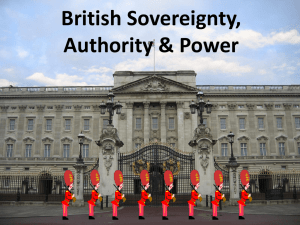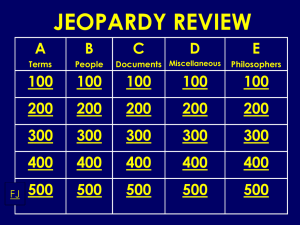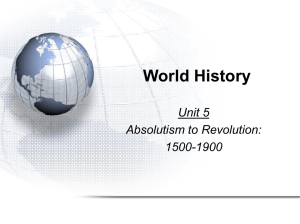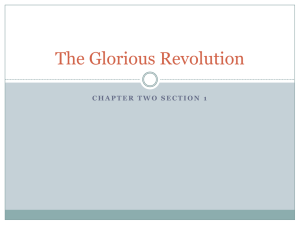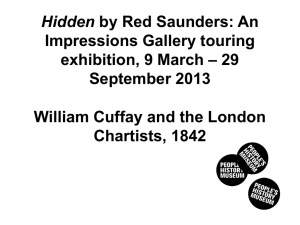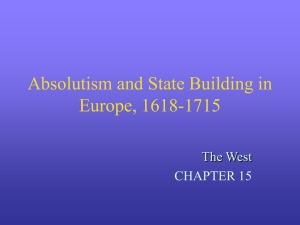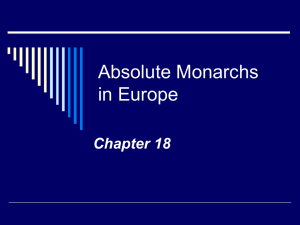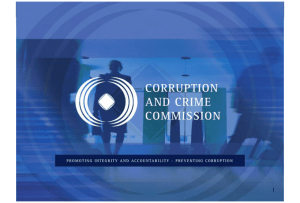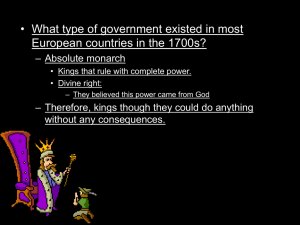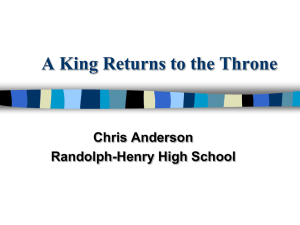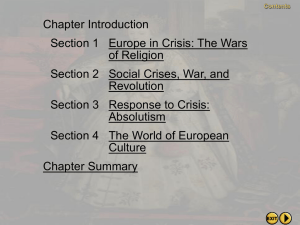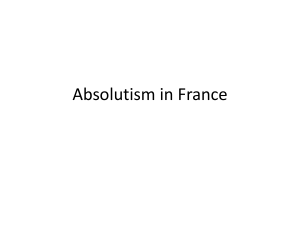Chapter 5 Absolutism
advertisement
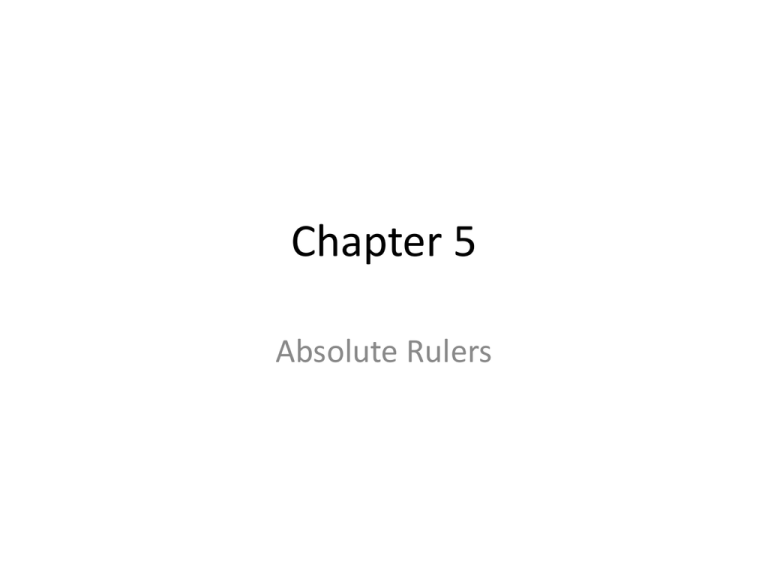
Chapter 5 Absolute Rulers • Absolutism – the political belief that one ruler should hold all the power within the boundaries of a country. • Causes – Religious and territorial conflicts created fear and uncertainty. – The growth of armies to deal with conflicts caused rulers to raise taxes to pay troops – Heavy taxes led to additional unrest and peasant revolts. • Effects – Rulers regulated religious worship and social gatherings to control the spread of ideas – Rulers increased the size of their courts to appear more powerful – Rulers created bureaucracies to control their countries’ economies • Absolute monarchs, kings or queens, held all of the power within their states’ boundaries. Their goal was to control every aspect of society. Absolute monarchs believed in divine right, the idea that God created the monarchy and that the monarch acted as God’s representative on earth. An absolute monarch answered only to God, not to his or her subjects. • The 17th century was a period of great upheaval in Europe. Religious and territorial conflicts between states led to almost continuous warfare. This caused governments to build huge armies and to levy even heavier taxes on an already suffering population. These pressures in turn brought about widespread unrest. Sometimes peasants revolted. • In response to these crises, monarchs tried to impose order by increasing their own power. As absolute rulers, they regulated everything from religious worship to social gatherings. They created new government bureaucracies to control their countries’ economic life. Their goal was to free themselves from the limitations imposed by the nobility and by representative bodies such as Parliament. Only with such freedom could they rule absolutely, as did the most famous monarch of his time, Louis XIV of France. Chapter 5 Section 2 • Henry IV (Henry of Navarre), the first of the Bourbon dynasty ruled France. He was a Huguenot but changed to Catholicism in order to avoid more wars. He passed the Edict of Nantes, a declaration of religious toleration, in 1598. It stated that Huguenots could live in peace in France and set up their own houses of worship. • When he died his son, Louis XIII, took over, but he was weak and so he appointed a strong minister to help him. Cardinal Richelieu, in effect, became the ruler of France. • Richelieu took steps to increase the power of the monarchy. First, he forbade Protestant cities to have walls. He did not want them to be able to defy the king and withdraw behind strong defenses. Second, he weakened the nobles’ power by ordering them to take down the walls to their fortified castles. He increased the power of government agents who came from the middle class. Richelieu also wanted to make France the strongest state in Europe and felt that the Hapsburgs were an obstacle to that end. (Hapsburgs ruled Spain, Austria, the Netherlands, and parts of the Holy Roman Empire.) This led to the Thirty Years’ War. Louis XIV • The efforts of Henry IV and Richelieu to strengthen the French monarchy paved the way for the most powerful ruler in French history – Louis XIV. • Louis XIV was 14 when he came to power and the true ruler was Richelieu’s successor, Cardinal Mazarin. • When Mazarin died, the 22 year old Louis took control of the government himself. Louis XIV • Louis devoted himself to helping France attain economic, political, and cultural brilliance. His finance minister, Jean Baptiste Colbert, believed in mercantilism and tried to make France selfsufficient. • To expand manufacturing, Colbert gave govt. funds and tax benefits to French companies, he placed a high tariff on imports, and encouraged people to migrate to France’s colony in Canada. There the fur trade added to French wealth. Louis XIV • Louis XIV’s palace at Versailles was proof of his absolute power. Only a ruler with total control over his country’s economy could afford such a lavish palace. • Under Louis, France was the most powerful country in Europe. Louis was known as the Sun King. • His many wars started to weaken France after smaller countries joined together to strike a balance of power, in which no single country or group of countries could dominate others. Chapter 5 Section 3 • For a brief while, the German rulers appeared to have settled their religious differences through the Peace of Augsburg (1555). They had agreed that the faith of each prince would determine the religion of his subjects. • The Thirty Years’ War was a conflict over religion and territory and for power among European ruling families. Chapter 5 Section 4 • Absolute rulers of Russia – Ivan the Terrible, the first czar, Peter the Great (Peter I) • He is known as Peter the Great because he was one of Russia’s greatest reformers. • Peter’s goal of westernization, of using western Europe as a model for change, was not an end in itself. Peter saw it as a way to make Russia stronger. Peter the Great • Peter believed that education was a key to Russia’s progress. • To promote education and growth, Peter wanted a seaport that would make it easier to travel to the West. • Peter built St. Petersburg on the Baltic coast on some swamp land. Parliament Limits the English Monarchy • Charles I tried to take power away from Parliament and a war broke out between followers of Charles and those of Parliament. • Supporters and opponents of King Charles fought the English Civil War. Those who remained loyal to Charles were called Royalists or Cavaliers. • On the other side were Puritan supporters of Parliament. Because these men wore their hair short over their ears, Cavaliers called them Roundheads. English Civil War • Puritans found a general who could win – Oliver Cromwell. His army defeated the Cavaliers. They captured Charles, tried him for treason and then executed him. • Cromwell abolished the monarchy and the House of Lords. He established a commonwealth, a republican form of govt. • Cromwell became a military dictator. Restoration and Revolution • Oliver Cromwell ruled until his death and then the Parliament asked the older son of Charles I to rule. • Charles II came to London in 1660. Because he restored the monarchy, the period of his rule is called the Restoration. • James II, Charles’ brother, became king when Charles died. Restoration and Revolution • James II was Catholic and he dissolved Parliament. English Protestants became terrified that a line of Catholic kings would rule England. • James had an older daughter, Mary, who was Protestant. Seven members of Parliament invited Mary and her husband William of Orange to overthrow James for the sake of Protestantism. Restoration and Revolution • When William led his army to London in 1688, James fled to France. This bloodless overthrow of King James II is called the Glorious Revolution. • At their coronation, William and Mary vowed to recognize Parliament as their partner in governing. England had become not an absolute monarchy but a constitutional monarchy, where laws limited the ruler’s power. English Bill of Rights • Parliament drafted a Bill of Rights in 1689 to make clear the limits of royal power. • This document listed many things a ruler could not do: – No suspending of Parliament’s laws – No levying of taxes without a specific grant from Parliament – No interfering with freedom of speech in Parliament – No penalty for a citizen who petitions the king about grievances Cabinet System • After 1688, no British monarch could rule without the consent of Parliament, and Parliament could not rule without the consent of the monarch. • This potential problem was remedied in the 1700s by the development of a group of government ministers, or officials, called the cabinet. Cabinet System • These ministers acted in the ruler’s name, but represented the major party of Parliament. • They became the link between the monarch and the major party in Parliament. • Over time, the cabinet became the center of power and policymaking. Under the cabinet system, the leader of the majority party in Parliament heads the cabinet and is called the prime minister. This system of English government continues today. Review • The English Bill of Rights was passed as a means to A. Limit Parliament’s power. B. Increase Parliament’s power C. Overthrow the monarch. D. Increase the monarch’s power. Answer is – Increase Parliament’s power.
